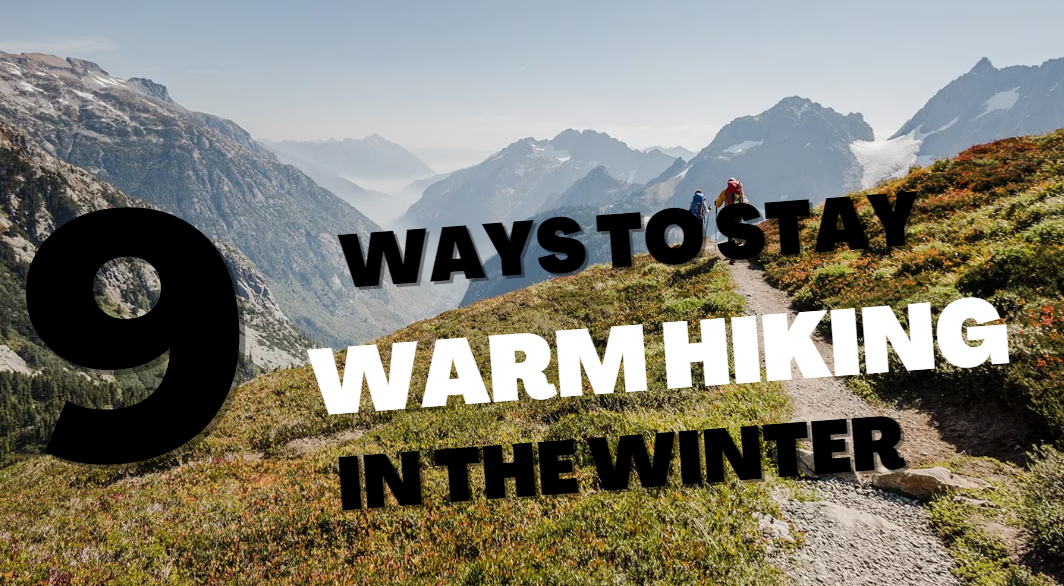
When winter's icy grip transforms the landscape into a serene wonderland, many adventurous souls find themselves drawn to the trails. Hiking in the winter offers a unique experience of tranquility and solitude, as well as breathtaking views of snow-covered landscapes.
However, with the beauty of winter also comes the challenge of staying warm in frigid conditions.
Whether you're a seasoned winter hiker or a newcomer to the world of snow-dusted paths, knowing how to stay warm on winter hikes is essential for both your safety and enjoyment.
In this blog post, we'll guide you through the art of winter hiking, providing invaluable tips and insights into the gear, clothing, and techniques that will keep you toasty as you explore the frozen wilderness.
From layering strategies to winter-specific gear recommendations, we've got you covered so you can embrace the cold with confidence and embark on unforgettable winter adventures.
So, bundle up, grab your hiking boots, and let's dive into the world of winter hiking warmth!
1) Heated Clothing

Heated clothes work by using electricity to warm up coils or wires that are sewn into the clothing. These coils or wires then transfer their heat to the surrounding fabric, which helps to keep you warm. Heated clothes can be a great way to stay warm on a winter hike, especially if you are prone to getting cold.
Here are some of the ways that heated clothes can keep you warm on a winter hike:
- They can help to prevent you from getting chilled. When you start to get cold, your body temperature drops. This can lead to hypothermia, a life-threatening condition. Heated clothes can help to keep your body temperature up, preventing you from getting chilled.
- They can help you to stay comfortable. When you are hiking in cold weather, it is important to stay comfortable. Heated clothes can help you to do this by providing a layer of warmth that will keep you from getting too cold.
- They can help you to perform better. When you are hiking in cold weather, it is important to be able to perform at your best. Heated clothes can help you to do this by providing a layer of warmth that will help you to stay focused and energized.
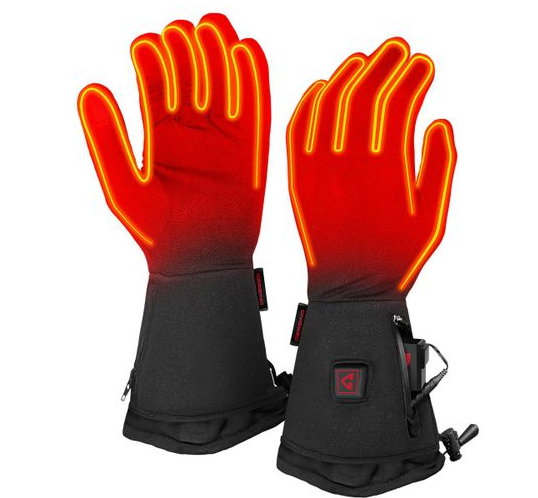
If you are planning on hiking in cold weather, heated clothes can be a great way to stay warm and comfortable. When choosing heated clothes, it is important to consider the following factors:
- The temperature range that the clothes are designed for.
- The type of insulation that is used.
- The battery life of the clothes.
- The weight and bulk of the clothes.
Heated clothes can be a great way to stay warm on a winter hike, but they are not a substitute for proper layering. You should still dress in layers, even if you are wearing heated clothes. This will help you to regulate your body temperature and stay comfortable.
I've written many guides on picking heated clothing.
Make sure to check out our other heated gear guides:
2) Dress In Layers

Here are the four essential layers of clothing you should wear when winter hiking:
- Base layer: This layer should be made of a moisture-wicking fabric, such as synthetic or merino wool. It will help to keep you dry and comfortable by transferring sweat away from your skin.
- Midlayer: This layer should provide insulation. It can be made of fleece, wool, or down.
- Outer layer: This layer should protect you from the wind and rain. It should be made of a waterproof and breathable fabric.
- Headwear: A hat will help to keep your head warm, which is one of the areas that loses heat the fastest.
- Gloves: Gloves will help to keep your hands warm.
- Neck gaiter: A neck gaiter can help to keep your neck and face warm.
- Socks: Socks should be made of a moisture-wicking fabric and should fit snugly.
When dressing in layers, it is important to start with a light base layer and add layers as needed. You can also remove layers if you start to get too warm. The goal is to stay comfortable and avoid sweating, as sweating can lead to hypothermia.
Here are some additional tips for dressing in layers for winter hiking:
- Choose fabrics that are moisture-wicking and breathable.
- Avoid cotton, as it will absorb sweat and make you cold.
- Make sure your clothes fit snugly, but not too tight.
- Layer your clothes so that you can adjust them as needed.
- Bring extra layers in case you get cold.
By following these tips, you can stay warm and comfortable on your next winter hike.
And don't forget, there's heated base layers too!
3) Proper Footwear
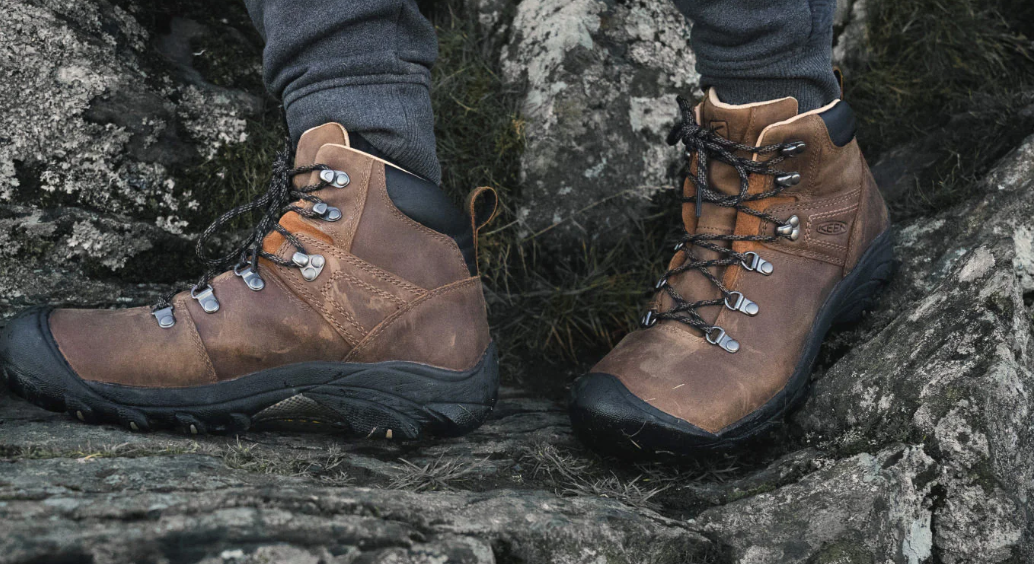
Proper footwear is essential for staying warm during the winter. Your feet are one of the most important parts of your body for keeping you warm, as they lose heat 25 times faster than the rest of your body. When your feet are cold, it can make it difficult to stay warm overall.
Here are some of the reasons why proper footwear is important for staying warm during the winter:
- Keeps your feet warm: Winter boots should be insulated to trap heat and keep your feet warm. They should also be waterproof to prevent your feet from getting wet, which can make them cold.
- Prevents slips and falls: Winter weather can be slippery, so it is important to wear footwear with good traction. This will help you to avoid slips and falls, which can lead to injury.
- Provides support: Winter boots should provide good support for your ankles and feet. This will help to prevent injuries, such as sprains and strains.
- Comfortable: Winter boots should be comfortable to wear. You should be able to walk and move around easily without feeling pain or discomfort.
When choosing winter footwear, it is important to consider the following factors:
- Temperature: The temperature will determine how insulated your boots need to be. If you will be spending time in very cold weather, you will need boots with more insulation.
- Activity: The type of activity you will be doing will also affect the type of footwear you need. If you will be doing a lot of walking or hiking, you will need boots with good traction and support.
- Fit: Your boots should fit snugly but not too tightly. You should have enough room to wiggle your toes.
- Materials: The materials used in your boots will affect their warmth, durability, and comfort. Choose boots made from materials that are moisture-wicking and breathable to help keep your feet dry and comfortable.
Here are some specific brands and products that I recommend for winter footwear:
- Boots: Sorel Caribou Winter Boots, L.L.Bean Bean Boots, Merrell Thermo Chill Mid Winter Boots
- Socks: Smartwool PhD Outdoor Light Hiking Socks, Darn Tough Hiking Socks
By following these tips, you can choose the right footwear to keep your feet warm and comfortable during the winter.
4) Protect Your Extremities
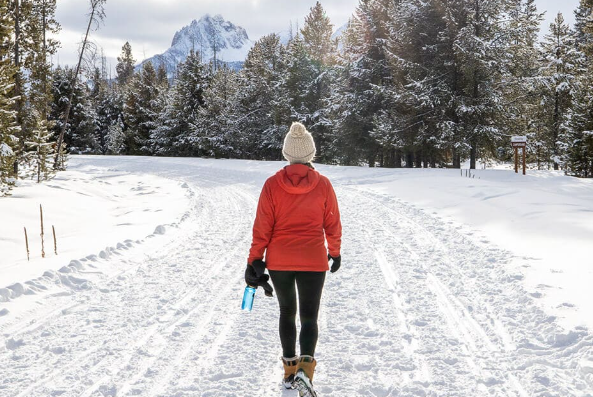
The extremities are the parts of your body that are furthest away from your core, such as your fingers, toes, ears, and nose. They are more prone to frostbite and hypothermia than other parts of your body because they lose heat more quickly.
Here are some of the reasons why it is important to protect your extremities while winter hiking:
- Frostbite: Frostbite is a condition that occurs when your skin and tissues freeze. It can cause pain, numbness, and discoloration. In severe cases, frostbite can lead to amputation.
- Hypothermia: Hypothermia is a condition that occurs when your body temperature drops below 95 degrees Fahrenheit. It can cause confusion, slurred speech, and loss of coordination. In severe cases, hypothermia can be fatal.
To protect your extremities while winter hiking, you should:
- Wear layers of clothing: This will help to trap heat and keep your extremities warm.
- Wear a hat and gloves: These will help to keep your head and hands warm, which are two of the areas that lose heat the fastest.
- Wear thick socks: These will help to keep your feet warm.
- Avoid getting your extremities wet: Wet clothing can conduct heat away from your body, making it more likely that you will get frostbite or hypothermia.
- Take breaks often: This will give your extremities a chance to warm up.
- Be aware of the signs of frostbite and hypothermia: If you start to feel pain, numbness, or discoloration in your extremities, seek medical attention immediately.
By following these tips, you can help to protect your extremities and stay safe while winter hiking.
Here are some additional tips for protecting your extremities while winter hiking:
- Bring a first-aid kit with you in case of frostbite or hypothermia.
- Let someone know where you are going and when you expect to be back.
- Be prepared to turn back if the conditions are too cold or dangerous.
5) Staying Dry
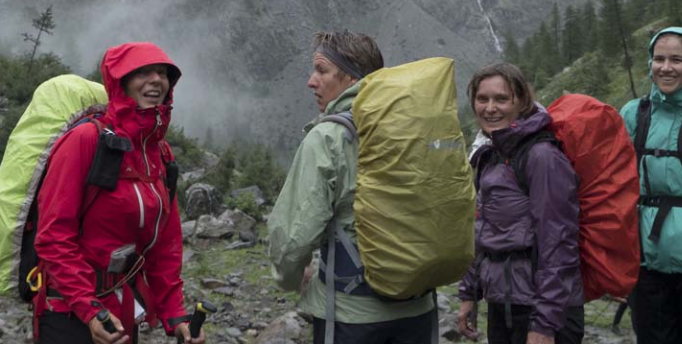
Staying dry is essential for staying warm while winter hiking. When you get wet, your body loses heat much faster. This can lead to hypothermia, a life-threatening condition.
Here are some of the reasons why it is important to stay dry while winter hiking:
- Wet clothing conducts heat away from your body: When your clothing gets wet, it loses its ability to insulate you. This means that heat will be conducted away from your body much faster, making you feel colder.
- Wet clothing can cause chafing: Chafing is a painful condition that can occur when skin rubs against skin or other materials. It is more likely to occur when your skin is wet.
- Wet clothing can weigh you down: Wet clothing can be heavy and cumbersome, making it difficult to hike.
To stay dry while winter hiking, you should:
- Wear waterproof clothing: This will help to keep your clothing dry and prevent you from getting wet.
- Avoid sweating: Sweating can make your clothing wet, so it is important to avoid sweating as much as possible.
- Change your clothes if they get wet: If your clothes get wet, change them as soon as possible.
- Bring a dry change of clothes: This will give you a dry set of clothes to wear if your current clothes get wet.
- Use a rain cover: A rain cover can help to protect your backpack and other gear from getting wet.
By following these tips, you can help to stay dry and warm while winter hiking.
Here are some additional tips for staying dry while winter hiking:
- Choose fabrics that are moisture-wicking and breathable.
- Avoid cotton, as it will absorb sweat and make you cold.
- Make sure your clothes fit snugly, but not too tight.
- Layer your clothes so that you can adjust them as needed.
- Bring extra layers in case you get wet.
6) Staying Active

Staying active while hiking in the winter is important for a few reasons.
- It helps you stay warm: When you are active, your body produces heat. This helps to keep you warm, even in cold weather.
- It helps to prevent hypothermia: Hypothermia is a condition that occurs when your body temperature drops too low. Staying active helps to keep your body temperature up and prevent hypothermia.
- It helps to prevent muscle cramps: Muscle cramps can occur when you are cold. Staying active helps to keep your muscles warm and prevent cramps.
- It helps to improve your mood: Exercise releases endorphins, which have mood-boosting effects. This can help to improve your mood and make your hike more enjoyable.
Here are some tips for staying active while hiking in the winter:
- Start slowly: If you are not used to hiking in cold weather, start slowly and gradually increase your activity level.
- Take breaks often: Take breaks often to warm up and rest.
- Drink plenty of fluids: Staying hydrated is important, especially in cold weather.
- Wear layers: This will allow you to adjust your clothing as needed to stay warm or cool.
- Be aware of the signs of hypothermia: If you start to feel cold, tired, or confused, seek medical attention immediately.
By following these tips, you can help to stay safe and enjoy your winter hike.
Here are some additional tips for staying active while hiking in the winter:
- Choose a trail that is appropriate for your fitness level.
- Let someone know where you are going and when you expect to be back.
- Be prepared for the weather conditions.
- Bring the necessary gear, such as a first-aid kit, extra food and water, and a flashlight.
7) Stay Hydrated
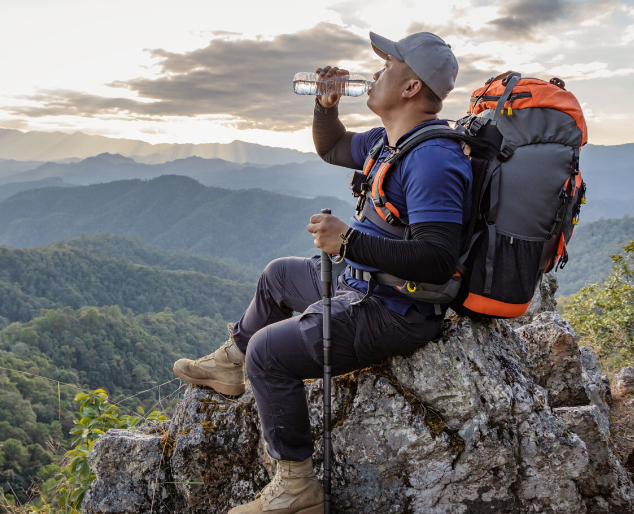
It is important to stay hydrated while hiking in the winter, even though you may not feel thirsty as often as you do in warmer weather. Here are some of the reasons why:
- Your body loses more fluids in cold weather: When you breathe in cold air, your body loses moisture through your lungs. You also lose fluids through your skin as you sweat.
- You may not feel thirsty as often: In cold weather, your body may not send signals to your brain that you are thirsty. This is because your body is trying to conserve fluids.
- Dehydration can lead to hypothermia: Hypothermia is a condition that occurs when your body temperature drops too low. Dehydration can make you more susceptible to hypothermia.
To stay hydrated while hiking in the winter, you should:
- Drink plenty of fluids: Aim to drink at least 16 ounces of water for every hour you are hiking.
- Choose fluids that are high in electrolytes: Electrolytes are minerals that help your body retain fluids. Good choices include sports drinks, coconut water, and diluted juice.
- Avoid alcohol and caffeine: Alcohol and caffeine can dehydrate you.
- Take breaks often: Take breaks often to drink fluids and warm up.
- Be aware of the signs of dehydration: The signs of dehydration include thirst, dry mouth, fatigue, and headache. If you experience any of these symptoms, drink more fluids immediately.
By following these tips, you can help to stay hydrated and safe while hiking in the winter.
Here are some additional tips for staying hydrated while hiking in the winter:
- Bring a water bottle with you.
- Drink fluids before, during, and after your hike.
- Eat foods that are high in water content, such as fruits and vegetables.
- Avoid sweating too much by dressing appropriately for the weather.
- If you are hiking in a dry climate, bring a water filter or purification tablets so that you can drink from natural sources.
8) Plan Your Route

Planning a route ahead of time is important for any hike, but it is especially important for winter hikes. This is because winter weather can be unpredictable and dangerous, and it is important to be prepared for anything.
Here are some of the reasons why it is important to plan a route ahead of time for a winter hike:
- Weather: Winter weather can change quickly, so it is important to know what the weather conditions are like before you start your hike. If the weather is bad, you may need to change your route or even cancel your hike altogether.
- Trail conditions: The trail conditions can also change quickly in winter, so it is important to know what the conditions are like before you start your hike. If the trail is icy or snow-covered, you may need to take extra precautions or choose a different route.
- Distance and elevation gain: Winter hikes can be longer and more challenging than summer hikes, so it is important to plan a route that is appropriate for your fitness level.
- Hazards: Winter hikes can be more dangerous than summer hikes due to the presence of ice, snow, and other hazards. It is important to be aware of the hazards in the area and to take steps to avoid them.
- Contingency plans: It is always a good idea to have a contingency plan in case something goes wrong on your hike. This could include having a way to contact someone for help, or knowing where to find shelter if you get caught in bad weather.
By planning your route ahead of time, you can help to ensure a safe and enjoyable winter hike.
Here are some tips for planning a route for a winter hike:
- Do your research: Before you start planning your route, do some research on the area where you will be hiking. This includes checking the weather forecast, learning about the trail conditions, and identifying any potential hazards.
- Choose a route that is appropriate for your fitness level: Winter hikes can be more challenging than summer hikes, so it is important to choose a route that is appropriate for your fitness level.
- Be flexible: The weather and trail conditions can change quickly in winter, so it is important to be flexible with your route. Be prepared to change your plans if necessary.
- Let someone know where you are going: Let someone know where you are going and when you expect to be back. This way, if you do not return on time, someone will know to look for you.
- Bring the necessary gear: In addition to the gear you would normally bring for a hike, be sure to bring extra layers of clothing, food, and water for winter conditions.
9) Check Weather Conditions
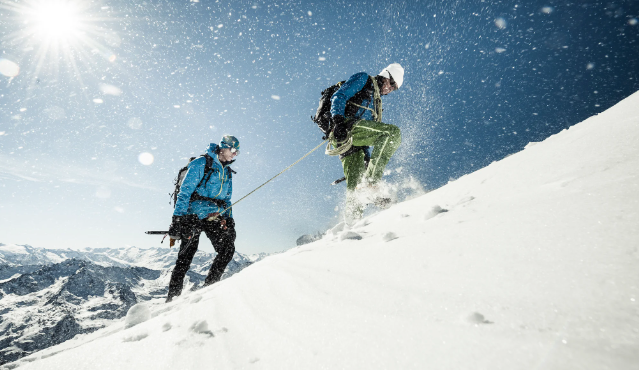
It is important to check the weather before going for a winter hike for the following reasons:
- To avoid dangerous conditions: Winter weather can be unpredictable and dangerous, so it is important to know what the conditions are like before you go hiking. If the weather is bad, you may need to change your plans or even cancel your hike altogether.
- To plan your hike accordingly: The weather can affect the length of your hike, the gear you need to bring, and the route you take. By checking the weather ahead of time, you can plan your hike accordingly and avoid any surprises.
- To stay safe: Hypothermia, frostbite, and other cold-weather injuries are a risk of winter hiking. By checking the weather, you can be aware of the risks and take steps to stay safe.
Here are some tips for checking the weather before a winter hike:
- Check the forecast: Check the weather forecast for the day of your hike and the days leading up to it. Pay attention to the temperature, precipitation, wind, and snow conditions.
- Check the avalanche forecast: If you are hiking in an area where avalanches are a risk, check the avalanche forecast. This will help you to assess the risk and plan your hike accordingly.
- Check the trail conditions: Check the trail conditions for the area you will be hiking in. This can be done by contacting the park or forest service, or by checking online resources.
- Be flexible: The weather can change quickly in winter, so it is important to be flexible with your plans. Be prepared to change your hike if necessary.
Wrapping Things Up
In the serene and often magical world of winter hiking, the key to a successful and enjoyable journey is staying warm. We've explored a multitude of strategies, from layering techniques to heated clothing innovations, all designed to keep you toasty and comfortable while you navigate the frosty trails.
As you prepare for your next winter adventure, remember that the most crucial factor is preparation itself.
By selecting the right gear, dressing appropriately, and arming yourself with the knowledge of how to stay warm in cold conditions, you're not only safeguarding your physical well-being but also unlocking the full potential of the winter wonderland that awaits.
Winter hiking isn't just about surviving the cold; it's about thriving in it. It's about connecting with nature in its most serene and pristine state. It's about forging memories that glisten as brightly as the snow beneath your boots.
So, when the cold winds beckon, and the trails are covered in a snowy embrace, embrace the season, and embark on your winter hike well-prepared, warm-hearted, and ready for the extraordinary.
Remember, the chill may nip at your cheeks, but the beauty of winter will warm your soul. Safe travels and happy hiking!
